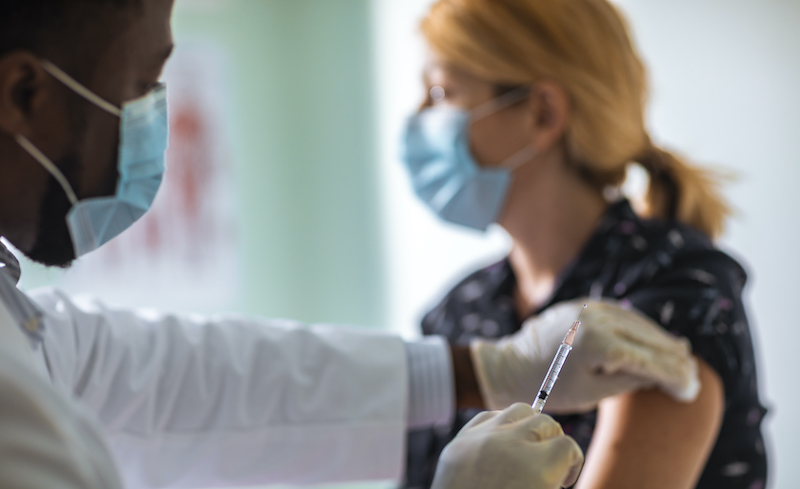While the US fiscal agreement and the Brexit deal reached in the waning days of 2020 should avert short-term economic headwinds, setbacks in the vaccine rollout will remain the biggest risk factor to global investors.
This is the view of several asset managers. NNIP argues that the reality of the challenge in vaccinating a meaningful part of the global population in a short time span is starting to sink in.
“A number of factors have already made it clear that most governments will miss their initial vaccination targets. These factors range from shortages of vaccine doses to health authorities’ ineffectiveness in organising mass vaccinations quickly and the IT constraints involved in monitoring and logging vaccine recipient data,” the firm says in its latest investment report.
See also: Fund picks 2021: Tapping into a world with a Covid-19 vaccine
Vaccination rates to become more closely watched than infection rates
NNIP adds that this, coupled with the still-high infection growth rates that are forcing authorities across the globe to extend or even tighten existing lockdowns, should remind us that the coronavirus crisis will likely remain the single most important risk for the global economy and financial markets over the coming quarters.
Jeroen Blokland, head of the multi-asset team at Robeco, agrees that the focus will shift to vaccination and that, to a large degree, markets will mirror vaccination success.
“Although investors will no doubt continue to monitor infection rates this year too, we think that vaccination rates will be by far the most important barometer of equity market sentiment in 2021.”
Richard Purkiss, portfolio manager with the global equity team at Robeco, is disappointed by the “pedestrian” early vaccination rates by healthcare agencies in all but a few countries where vaccines have now been approved and suggests that a return to normal by the end of summer is already looking highly improbable.
“To be relatively certain of avoiding most of the worst economic impacts of the pandemic by the end of September, the global vaccination rate would need to reach 30 million per day for a vaccine that requires two doses.”
He adds: “Our estimate assumes that herd immunity would begin to kick in at the 70% level of vaccination or infection in the population. This could be relatively optimistic, particularly if either of the recently identified and apparently more transmissible UK or South African variants were to become dominant strains worldwide over 2021.”
See also: Andrzej Pioch: How we played equities through the US elections and vaccine breakthrough
How to play an uneven rate of vaccination across the globe
Given this backdrop, Blokland argues that for investors it means taking a much more cautious approach until there is more clarity. The portfolio manager has been taking risk off the table since the severity of the latest outbreak became known.
Vincent Mortier, deputy chief investment officer at Amundi, is also wary of being overly positive on the vaccine facilitating a return to normality.
He told Portfolio Adviser sister publication Expert Investor: “The market rally leading up to December was based on blind faith in the vaccine and on the brave assumption that very soon, everything will revert to as it was before (or even better, thanks to fiscal and monetary support).”
He adds: “This is a risk: producing and distributing these vaccines on such a large scale won’t be a walk in the park. I also worry that markets assume a large majority of the population will be vaccinated within a few weeks. But look at the high levels of scepticism with regards to taking the vaccine?”
Monica Defend, global head of research at Amundi, added: “The duration of the pandemic will ultimately determine the form of recovery, and that is likely to vary significantly across the globe. The slow, uneven and multi-speed recovery will differ by sector and country, and as such investors need to take advantage of these divergences in growth profiles.”
See also: Vaccine could prompt fresh wave of new clients for wealth managers and advisers
Positive vaccine news could deliver bad news within credit
Foppe-Jan van der Meij, senior portfolio manager fixed income credits at Actiam, is another who thinks a recovery timescale is difficult to pin down right now.
He told EI: “With the vaccine rollout, a dot was set on the horizon, although we still don’t know when we’ll get back to normal. Currently the credit environment is positive.
“Low growth and low inflation contribute to a healthy macro environment for credit and the low interest rate contributes to low financing costs. And we must not forget the buying programme of the Central Bank that is supporting the spreads.”
He adds that the closer we get back to normal, the greater the chance that the stimulus packages will be phased out. Therefore, it becomes more likely that we will see in the second half of 2021 a rise in interest rates and a rise in defaults for lower rated (sub-investment grade) paper that can also be a catalyst for a spread widening in investment grade paper.
“We prefer to play the spread compression theme with subordinated paper from high quality names. We are cautious with Covid-19 related names. Although some big national champions are saved by their government, not every country is that friendly and these finance packages are not endless.”
He concludes: “The current crisis confirms that financial and social impact are tied together. In our portfolio we make therefore extensive use of sustainable bonds. Bonds were the use of proceeds are used for the benefit of Green or Social projects. Examples of that are the EU Sure programme and the Covid-19 thematic (Social) bond of BBVA.”
See also: Moderna solidifies market dynamics with second dose of positive vaccine news
Hiccups with vaccine rollout have so far failed to hit investor appetite
The view at NNIP is that while there may be some dips along the way, the preference remains for riskier assets.
It points out in its latest report that investor risk appetite so far remains largely insulated from the disappointments about the speed of vaccinations and the effectiveness in containing the virus.
Investors seem confident in an economic recovery that gains pace in the second half of the year.
“While we see clear risks of new growth disappointments in the near term, we also think the combination of mass vaccinations (despite their stuttering start) and robust monetary and fiscal policy support (in US and Europe) should provide for a strong growth rebound later this year,” NNIP says.
The investment manager believes that global monetary support is still a positive driver for all risky assets. Moreover, it expects 25% earnings growth for 2021, driven by economic stimulus, the gradual normalisation of economic activity and higher profit margins.
It says absolute valuation metrics are high but should be viewed in the light of continuously accommodative monetary policy.
Several survey-based indicators like the bull/bear ratio show signs of exuberance and, as NNIP outlines, dramatic Bitcoin price moves also demonstrate the strength of risk appetite.
While the lack of correlation to other asset classes may attract some investors; there can be little doubt that the cryptocurrency promises a white-knuckle ride for investors. Bitcoin saw its valuation plummet over 25% this week.
See also: Investor euphoria over Covid vaccine tempered by questions around roll out
For more insight on continental European investment, please click on www.expertinvestoreurope.com









